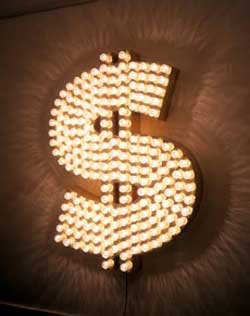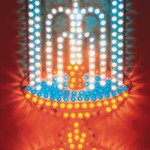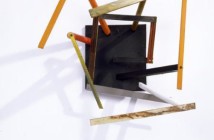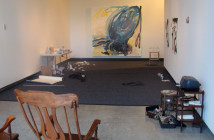The work of Tim Noble and Sue Webster, now on view at the MFA, is one of the more unique contemporary exhibitions Boston has displayed in years. The British couple, partners in both art and life, have been showing consistently for a few years and it is a delight the Museum has given these young artists a showcase early in their career. The show opens with a glitzy fountain titled Excessive Sensual Indulgence where different colored lights flicker seductively, forming the image of a schematic fountain. The colorful, bright object functions to pacify viewers, making them in awe of the image. This feeling is comparable to the stimulation of Las Vegas, where the power and indulgence of the “show” overpowers the content behind it. This is a clear intention by the artists who seem both seduced by and critical of the overpowering seduction of money. This is more evident in the fantastic flickering object $, where the familiar dollar sign leans casually against the back wall, symbolizing ultimate excess and indulgence.
Joining $ in the same gallery is Girlfriend from Hell and Puny Undernourished Kid. Here, neon tubing forms a pair of stick figures that have been covered with drawing, slang, and poetic language like, “Take my Tits” or simply “Fuck you.” Almost obliterated with graffiti marks, the “tagged” figures seem only slightly rattled by the assault on their bodies. Their commanding height and bright colors give an imposing aura over any onlookers, baiting the world to dish out more.
Perhaps the most interesting body of work the tandem has developed is their signature shadow sculptures. Made from heaps of trash that form what appear to be nothing in particular; hit with a light at just the right angle form perfect silhouettes. The mound of cans, scraps of wood, saws and other bits of crap in Real Life is Rubbish offer little evidence of how it magically produces an image of the couple sitting on a bench. The amount of precision in the arrangement of the trash give the shadow an amazing amount of detail- hair tweaked in just such a way, crossed legs, and a nonchalant slouch are all rendered in perfect proportion. The same could be said of the nearby cityscape where multiple cans with what appear to be shotgun holes convene on a bench to produce a beautiful image of the Manhattan skyline. Though once the lights are unplugged (or obstructed by other museum visitors) these images are lost, reducing the forms to arbitrary mounds of junk.
The fact that the cityscape and couple could not be found without the aid of the light makes these images in some way ephemeral, though this emphera is allowed to be reproduced over and over again. This dialectic is noteworthy, because to continue to replicate these images, one has to preserve trash. These heaps of thrown away commodities, already consumed and a mere relic of their former utility, are preserved to reproduce a spectacle. It is the safekeeping of the spectacle that allows the logic of capital to continue unifying people by social relationships that are mediated by images. What makes Noble and Webster’s project significant is the allowance to see what produces the spectacle. Viewers are not only rendered as passive consumers to an overpowering image, but are privy to what maintains it, the never ending cycle of consumption. Guy Debord writes: “The spectacle corresponds to the historical moment at which the commodity completes its colonization of social life. It is not just that the relationship to commodities is now plain to see- commodities are now all that there is to see; the world we see is the world of the commodity.”
Links:
The Museum of Fine Arts, Boston
Tim Noble & Sue Webster is on view in the Foster Gallery at the MFA through September 6th.






